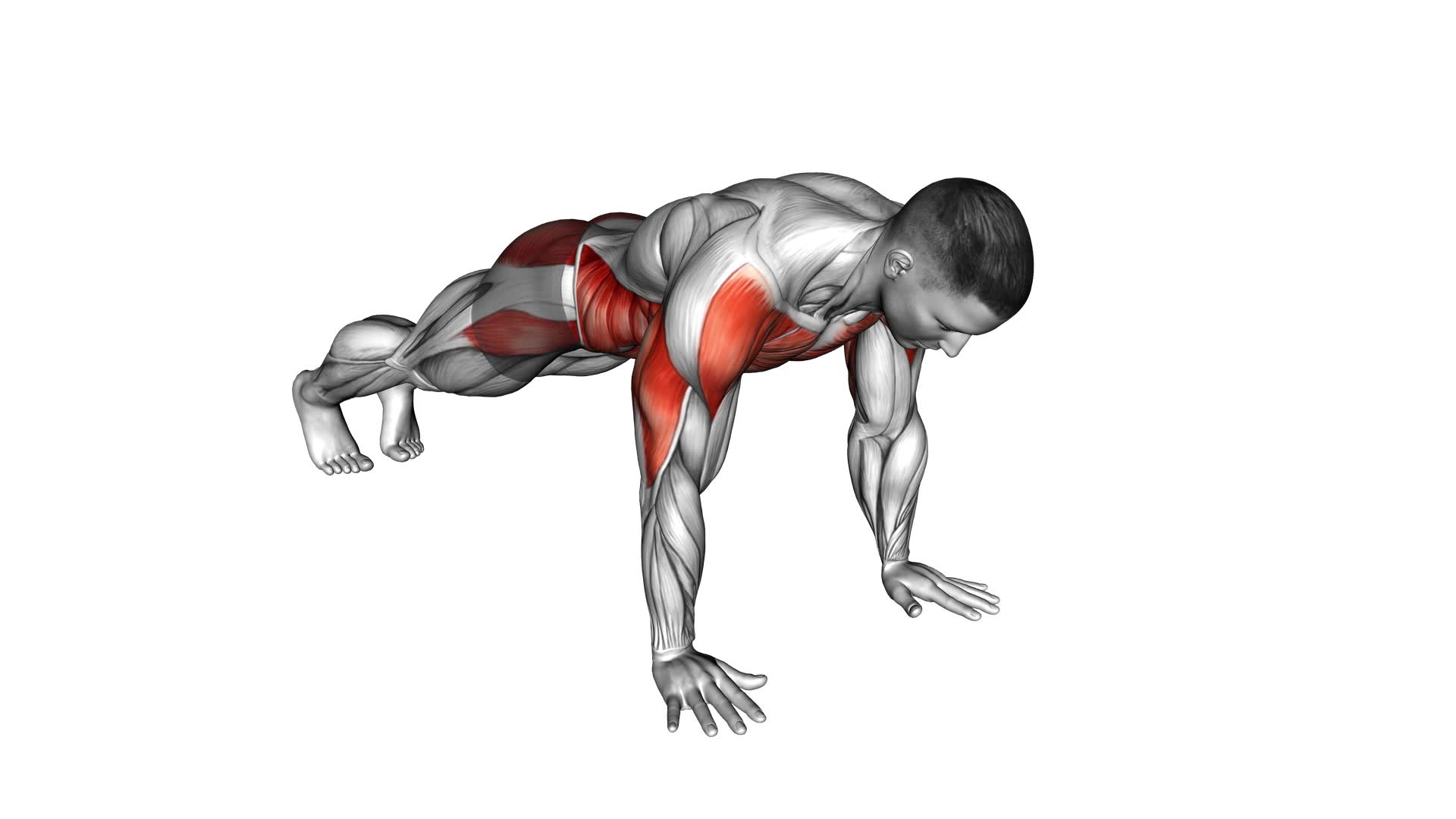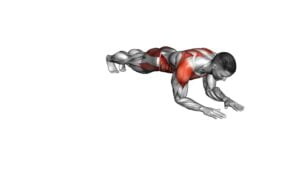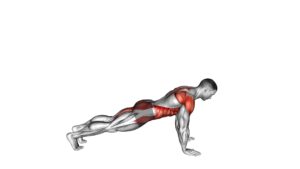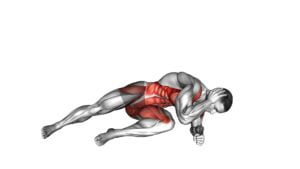Plank Side Walk (male) – Video Exercise Guide & Tips

Looking to level up your exercise routine? Check out this video exercise guide and tips for the plank side walk. Get ready to challenge yourself and strengthen your core with this effective exercise.
Watch This Exercise Video
Learn proper form, variations, and modifications to maximize your results. Avoid common mistakes and get expert advice on incorporating the plank side walk into your workout routine.
Let's get started and take your fitness to the next level!
Key Takeaways
- Plank Side Walk improves core strength and enhances stability.
- It engages multiple muscle groups simultaneously, increasing overall body control.
- Plank Side Walk helps prevent injuries during physical activities.
- Proper form and technique, as well as variations and progressions, are important for a safe and effective workout.
Benefits of the Plank Side Walk
The plank side walk offers numerous benefits for you. This exercise isn't only effective but also efficient in improving your core strength and increasing stability. By engaging your core muscles, including the abdominals, obliques, and lower back, the plank side walk helps to strengthen and stabilize your midsection. This, in turn, can lead to improved posture and reduced risk of lower back pain.
In addition to core strength, the plank side walk also targets the muscles in your shoulders, arms, and legs. As you move laterally, you're challenging these muscles to support your body weight and maintain stability. This can help to improve overall body coordination and balance.
Furthermore, the plank side walk is a functional exercise that mimics real-life movements, such as sidestepping or shuffling. By practicing this exercise, you can enhance your ability to perform daily activities that require stability and control, such as walking, running, or even carrying groceries.
To reap the benefits of improved core strength and increased stability, incorporate the plank side walk into your regular workout routine. Start by assuming a plank position, then step your hand and foot out to the side, alternating sides. Aim for controlled and controlled movements, focusing on engaging your core throughout the exercise. Remember to breathe and maintain proper form to maximize the effectiveness of this exercise.
Proper Form and Technique for the Exercise
Maintain proper form and technique for the plank side walk exercise to maximize its benefits. Follow these tips for proper form to ensure you're getting the most out of this exercise:
- Keep your body in a straight line: Avoid sagging or arching your back. Engage your core muscles and imagine a straight line from your head to your heels.
- Engage your glutes: Squeeze your glutes throughout the exercise to activate those muscles and increase the effectiveness of the plank side walk.
- Maintain a steady pace: Move from side to side in a controlled manner. Avoid rushing through the exercise, as this can compromise your form and lead to injury.
- Watch your hand placement: Keep your hands directly beneath your shoulders and distribute your weight evenly between both hands. This will help you maintain stability and prevent straining your wrists.
By following these tips for proper form, you can ensure that you're performing the plank side walk exercise correctly and reaping the maximum benefits.
Now, let's explore some variations and modifications to challenge yourself even further.
Variations and Modifications to Challenge Yourself
To challenge yourself further, try incorporating variations and modifications into your plank side walk exercise routine.
These advanced progressions can help increase muscle activation and take your workout to the next level.
One modification you can try is adding a resistance band around your legs. This will create extra tension and require more strength to perform the exercise.
You can also increase the difficulty by using a stability ball. Place your feet on the ball instead of the ground, forcing your core muscles to work harder to maintain stability.
Another variation to try is the single-arm plank side walk. Instead of using both arms to move, focus on using only one arm while keeping the other arm extended to the side.
This will challenge your core stability and increase the demand on your shoulders and arms.
If you're looking for an even greater challenge, you can try the plank side walk with a knee tuck. As you move sideways, bring one knee towards your chest and then extend it back out before taking the next step.
This modification adds an extra element of balance and coordination to the exercise.
Incorporating these variations and modifications into your plank side walk routine will help you push your limits and continue to progress in your fitness journey.
Remember to always listen to your body and adjust the difficulty level as needed.
Common Mistakes to Avoid While Performing the Plank Side Walk
When performing the plank side walk, it's important to avoid common mistakes that can hinder your progress and potentially lead to injury. Here are four common mistakes to avoid and tips on maintaining proper form:
- Allowing your hips to sag: Keep your body in a straight line from head to heels. Engage your core muscles to prevent your hips from dropping or sagging.
- Moving too quickly: Slow and controlled movements are key to getting the most out of the plank side walk. Rushing through the exercise can lead to poor form and decrease the effectiveness of the workout.
- Failing to engage your shoulders: Your shoulders should also be engaged during the plank side walk. Avoid rounding your shoulders or allowing them to collapse. Instead, actively push through your hands and engage your shoulder muscles.
- Not keeping your gaze down: Keep your head in line with your spine and avoid looking up or forward. This helps to maintain proper alignment and prevents strain on your neck.
Tips for Incorporating the Exercise Into Your Workout Routine
To effectively incorporate the plank side walk into your workout routine, focus on performing the exercise with proper form and gradually increasing the intensity. Here are some tips to help you get started:
- Warm up: Before attempting the plank side walk, ensure that your body is properly warmed up. This will help prevent injuries and improve your overall performance.
- Engage your core: The plank side walk primarily targets your core muscles. To get the most out of this exercise, make sure to engage your core by pulling your belly button towards your spine. This will help stabilize your body and maximize the benefits.
- Maintain proper form: As you perform the plank side walk, it's important to maintain a straight line from your head to your toes. Avoid lifting or sagging your hips, as this can strain your lower back. Keep your shoulders relaxed and your neck in a neutral position.
- Gradually increase intensity: Start with a shorter distance and gradually increase the length of your side walks as you build strength and endurance. This will help you progress safely and avoid overexertion.
Incorporating the plank side walk into your workout routine can help improve core strength, stability, and overall body control. Remember to listen to your body and make adjustments as needed. With consistent practice, you'll soon reap the benefits of this challenging exercise.
Frequently Asked Questions
How Many Sets and Reps Should I Do for the Plank Side Walk Exercise?
To determine the number of sets and reps for the plank side walk exercise, it's important to consider your fitness level and goals. Start with 2-3 sets of 10-12 reps, focusing on maintaining proper form and engaging your core muscles.
As you progress, you can increase the number of sets and reps. To make the exercise more challenging, try incorporating variations such as adding a resistance band or increasing the distance of the side walk.
Can I Do the Plank Side Walk Exercise if I Have Lower Back Pain?
If you're experiencing lower back pain, it's important to modify the plank side walk exercise to avoid further discomfort. Instead of performing the exercise on your hands and toes, try doing it on your forearms and knees. This will reduce the strain on your lower back.
Alternatively, you can try other exercises that target your core and obliques without putting pressure on your back, such as side planks or bird dogs.
Always listen to your body and consult with a healthcare professional if needed.
Is It Necessary to Warm up Before Performing the Plank Side Walk Exercise?
Yes, warming up before performing the plank side walk exercise is necessary. It helps prepare your muscles and joints for the movement and reduces the risk of injury.
By gently increasing your heart rate and loosening up your body, you enhance blood flow and flexibility. This allows you to perform the exercise more effectively and get the most out of it.
Additionally, warming up can improve your overall performance and help you achieve better results.
Can I Do the Plank Side Walk Exercise on a Yoga Mat Instead of a Hard Surface?
Yes, you can definitely do the plank side walk exercise on a yoga mat instead of a hard surface. Using a yoga mat provides several benefits such as added comfort and cushioning for your hands and knees.
Additionally, it can help prevent slipping and provide stability during the exercise. Just make sure to choose a non-slip yoga mat and adjust your movements accordingly.
How Can I Progress and Make the Plank Side Walk Exercise More Challenging Over Time?
To make the plank side walk exercise more challenging over time, there are several progression options you can try.
One way is to increase the duration of the exercise by holding the plank position for longer periods.
You can also add resistance by wearing a weighted vest or using resistance bands.
Another option is to incorporate modifications like lifting one leg or one arm off the ground while performing the side walk.
These variations will help to increase the difficulty and continue challenging your muscles.
Conclusion
Incorporating the plank side walk into your workout routine offers numerous benefits, including improved core strength, stability, and balance.
By maintaining proper form and technique, you can maximize the effectiveness of this exercise. Additionally, challenging yourself with variations and modifications will help you continue to progress and see results.
Avoid common mistakes to ensure a safe and effective workout.
Start adding the plank side walk to your routine today and experience the benefits for yourself.

Author
Years ago, the spark of my life’s passion ignited in my mind the moment I stepped into the local gym for the first time. The inaugural bead of perspiration, the initial endeavor, the very first surge of endorphins, and a sense of pride that washed over me post-workout marked the beginning of my deep-seated interest in strength sports, fitness, and sports nutrition. This very curiosity blossomed rapidly into a profound fascination, propelling me to earn a Master’s degree in Physical Education from the Academy of Physical Education in Krakow, followed by a Sports Manager diploma from the Jagiellonian University. My journey of growth led me to gain more specialized qualifications, such as being a certified personal trainer with a focus on sports dietetics, a lifeguard, and an instructor for wellness and corrective gymnastics. Theoretical knowledge paired seamlessly with practical experience, reinforcing my belief that the transformation of individuals under my guidance was also a reflection of my personal growth. This belief holds true even today. Each day, I strive to push the boundaries and explore new realms. These realms gently elevate me to greater heights. The unique combination of passion for my field and the continuous quest for growth fuels my drive to break new ground.







